Case Concerning Oil Platforms (Iran v. United States)
VerifiedAdded on 2022/12/29
|9
|2468
|69
AI Summary
This report discusses the case of Oil Platforms between Iran and the United States, including the background, legal issues, arguments by the parties, and the judgment of the court. It also highlights the significance of the case and provides a bibliography for further reading.
Contribute Materials
Your contribution can guide someone’s learning journey. Share your
documents today.
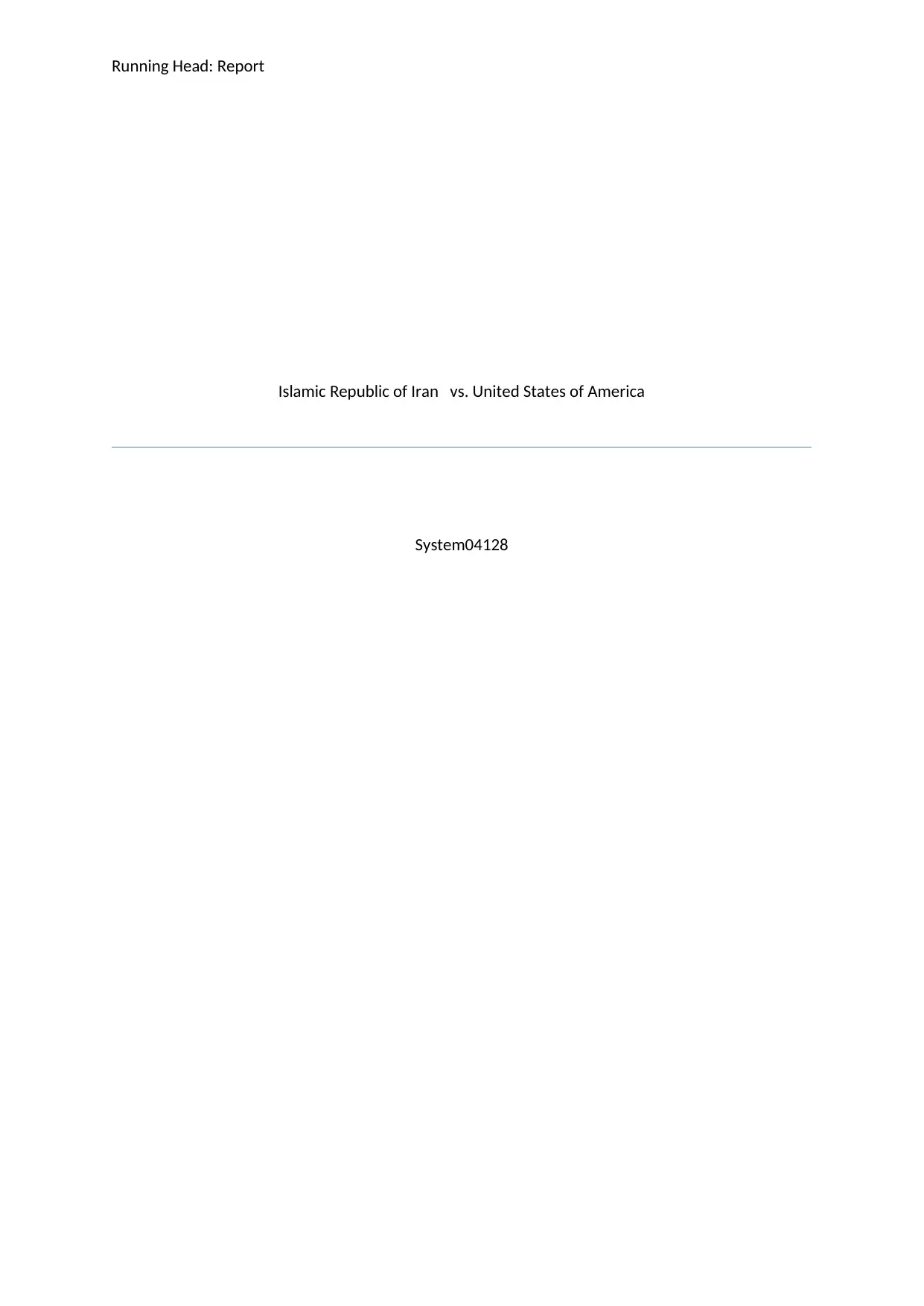
Running Head: Report
Islamic Republic of Iran vs. United States of America
System04128
Islamic Republic of Iran vs. United States of America
System04128
Secure Best Marks with AI Grader
Need help grading? Try our AI Grader for instant feedback on your assignments.
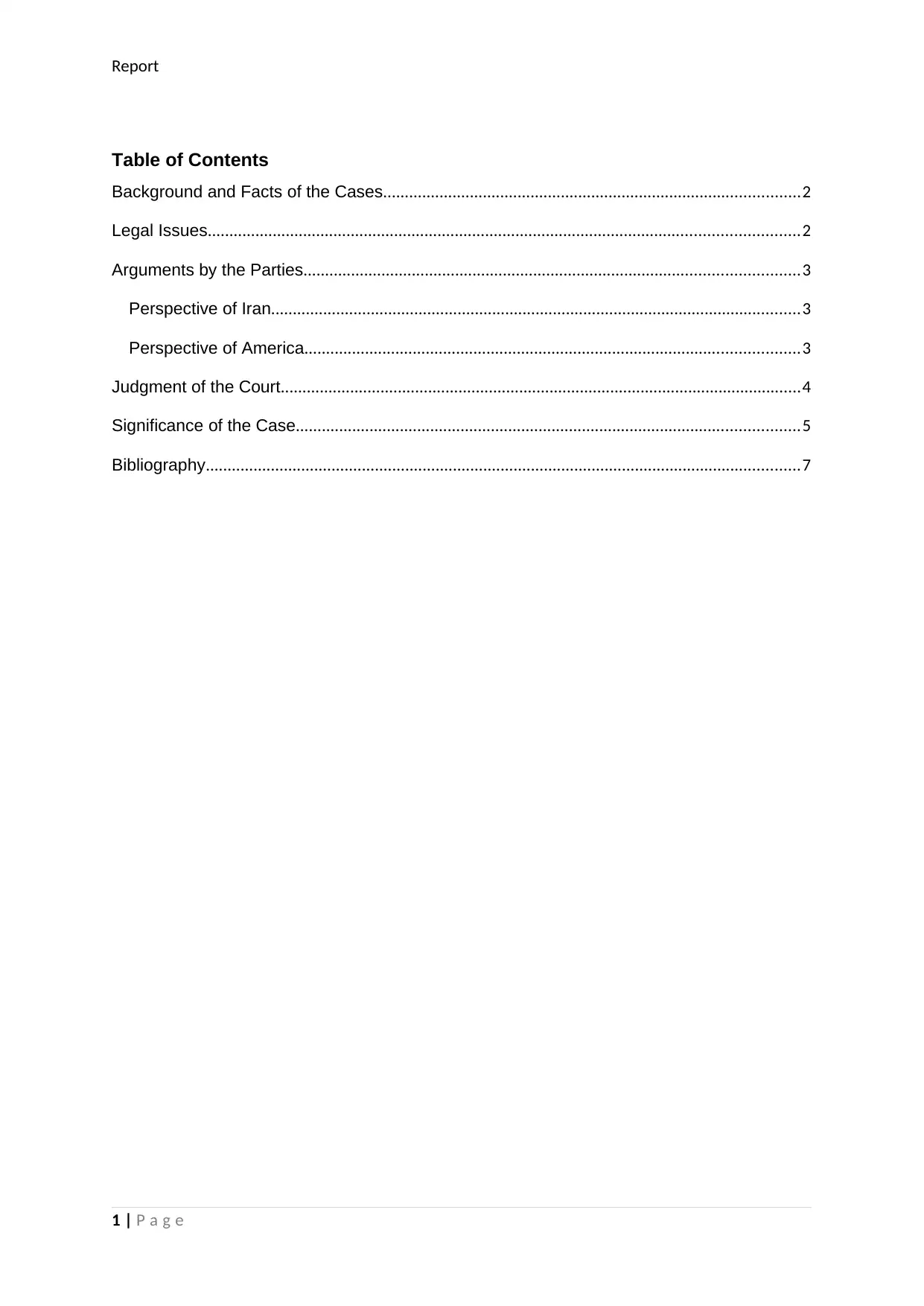
Report
Table of Contents
Background and Facts of the Cases................................................................................................2
Legal Issues........................................................................................................................................2
Arguments by the Parties..................................................................................................................3
Perspective of Iran..........................................................................................................................3
Perspective of America..................................................................................................................3
Judgment of the Court........................................................................................................................4
Significance of the Case....................................................................................................................5
Bibliography.........................................................................................................................................7
1 | P a g e
Table of Contents
Background and Facts of the Cases................................................................................................2
Legal Issues........................................................................................................................................2
Arguments by the Parties..................................................................................................................3
Perspective of Iran..........................................................................................................................3
Perspective of America..................................................................................................................3
Judgment of the Court........................................................................................................................4
Significance of the Case....................................................................................................................5
Bibliography.........................................................................................................................................7
1 | P a g e
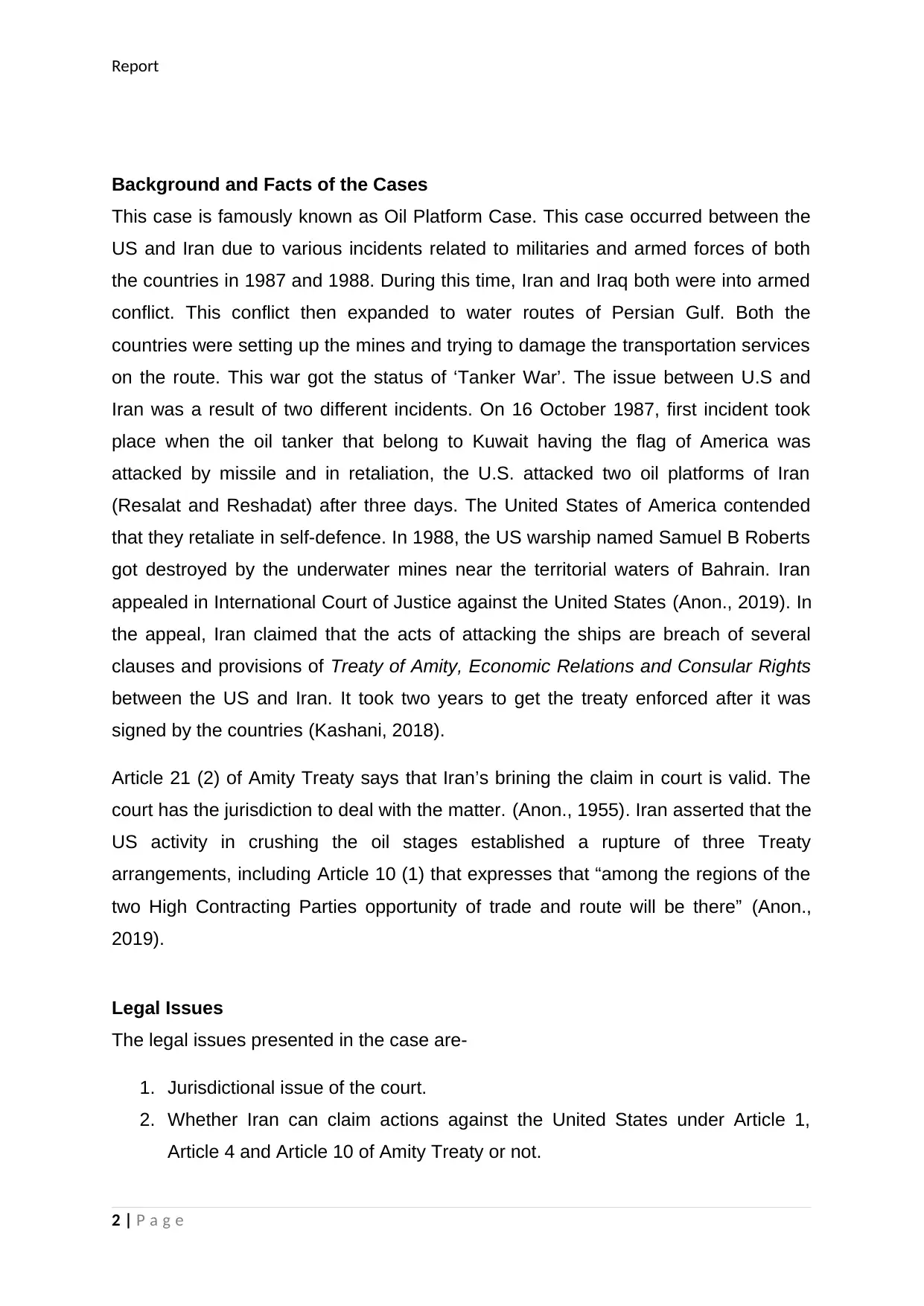
Report
Background and Facts of the Cases
This case is famously known as Oil Platform Case. This case occurred between the
US and Iran due to various incidents related to militaries and armed forces of both
the countries in 1987 and 1988. During this time, Iran and Iraq both were into armed
conflict. This conflict then expanded to water routes of Persian Gulf. Both the
countries were setting up the mines and trying to damage the transportation services
on the route. This war got the status of ‘Tanker War’. The issue between U.S and
Iran was a result of two different incidents. On 16 October 1987, first incident took
place when the oil tanker that belong to Kuwait having the flag of America was
attacked by missile and in retaliation, the U.S. attacked two oil platforms of Iran
(Resalat and Reshadat) after three days. The United States of America contended
that they retaliate in self-defence. In 1988, the US warship named Samuel B Roberts
got destroyed by the underwater mines near the territorial waters of Bahrain. Iran
appealed in International Court of Justice against the United States (Anon., 2019). In
the appeal, Iran claimed that the acts of attacking the ships are breach of several
clauses and provisions of Treaty of Amity, Economic Relations and Consular Rights
between the US and Iran. It took two years to get the treaty enforced after it was
signed by the countries (Kashani, 2018).
Article 21 (2) of Amity Treaty says that Iran’s brining the claim in court is valid. The
court has the jurisdiction to deal with the matter. (Anon., 1955). Iran asserted that the
US activity in crushing the oil stages established a rupture of three Treaty
arrangements, including Article 10 (1) that expresses that “among the regions of the
two High Contracting Parties opportunity of trade and route will be there” (Anon.,
2019).
Legal Issues
The legal issues presented in the case are-
1. Jurisdictional issue of the court.
2. Whether Iran can claim actions against the United States under Article 1,
Article 4 and Article 10 of Amity Treaty or not.
2 | P a g e
Background and Facts of the Cases
This case is famously known as Oil Platform Case. This case occurred between the
US and Iran due to various incidents related to militaries and armed forces of both
the countries in 1987 and 1988. During this time, Iran and Iraq both were into armed
conflict. This conflict then expanded to water routes of Persian Gulf. Both the
countries were setting up the mines and trying to damage the transportation services
on the route. This war got the status of ‘Tanker War’. The issue between U.S and
Iran was a result of two different incidents. On 16 October 1987, first incident took
place when the oil tanker that belong to Kuwait having the flag of America was
attacked by missile and in retaliation, the U.S. attacked two oil platforms of Iran
(Resalat and Reshadat) after three days. The United States of America contended
that they retaliate in self-defence. In 1988, the US warship named Samuel B Roberts
got destroyed by the underwater mines near the territorial waters of Bahrain. Iran
appealed in International Court of Justice against the United States (Anon., 2019). In
the appeal, Iran claimed that the acts of attacking the ships are breach of several
clauses and provisions of Treaty of Amity, Economic Relations and Consular Rights
between the US and Iran. It took two years to get the treaty enforced after it was
signed by the countries (Kashani, 2018).
Article 21 (2) of Amity Treaty says that Iran’s brining the claim in court is valid. The
court has the jurisdiction to deal with the matter. (Anon., 1955). Iran asserted that the
US activity in crushing the oil stages established a rupture of three Treaty
arrangements, including Article 10 (1) that expresses that “among the regions of the
two High Contracting Parties opportunity of trade and route will be there” (Anon.,
2019).
Legal Issues
The legal issues presented in the case are-
1. Jurisdictional issue of the court.
2. Whether Iran can claim actions against the United States under Article 1,
Article 4 and Article 10 of Amity Treaty or not.
2 | P a g e
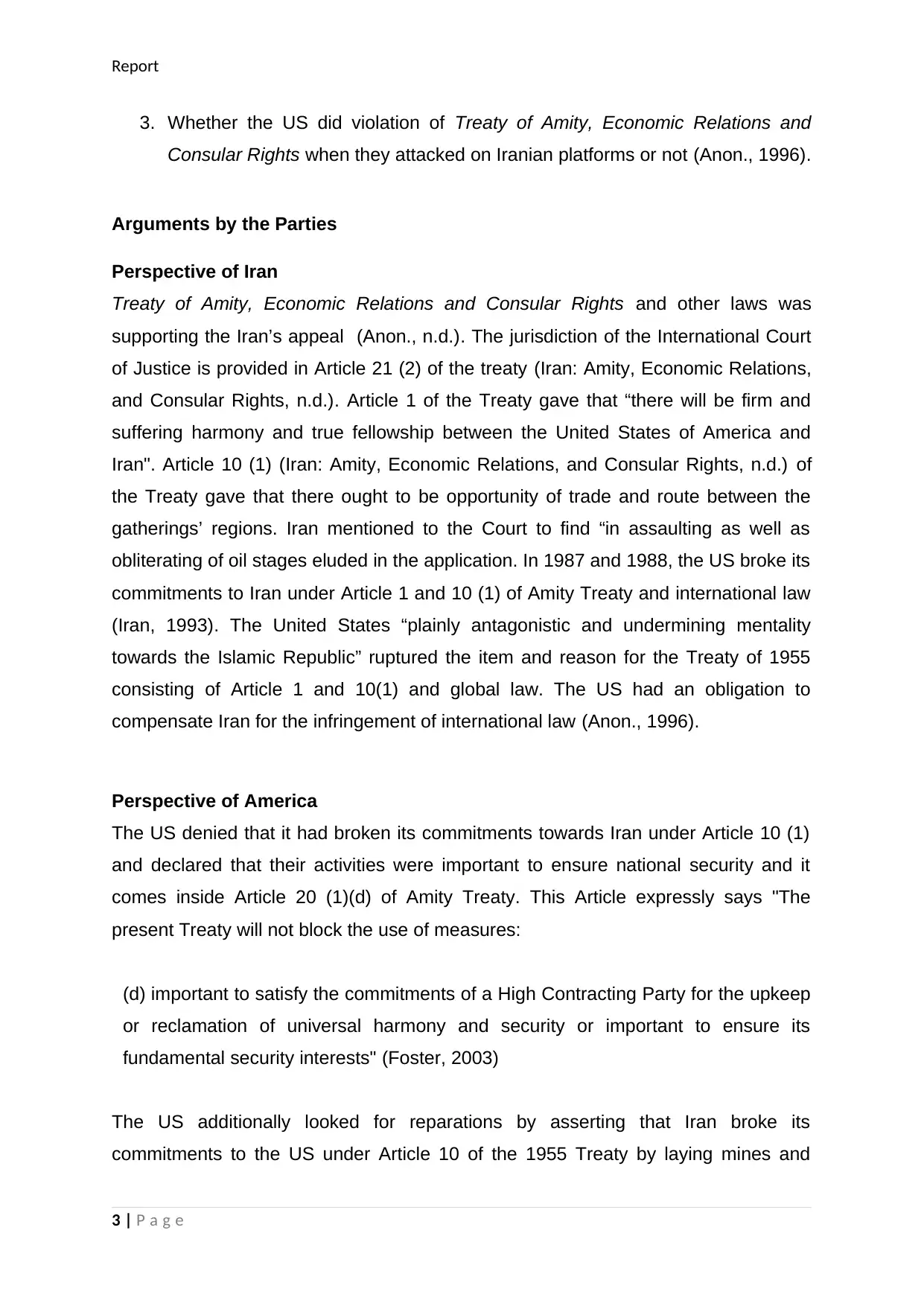
Report
3. Whether the US did violation of Treaty of Amity, Economic Relations and
Consular Rights when they attacked on Iranian platforms or not (Anon., 1996).
Arguments by the Parties
Perspective of Iran
Treaty of Amity, Economic Relations and Consular Rights and other laws was
supporting the Iran’s appeal (Anon., n.d.). The jurisdiction of the International Court
of Justice is provided in Article 21 (2) of the treaty (Iran: Amity, Economic Relations,
and Consular Rights, n.d.). Article 1 of the Treaty gave that “there will be firm and
suffering harmony and true fellowship between the United States of America and
Iran". Article 10 (1) (Iran: Amity, Economic Relations, and Consular Rights, n.d.) of
the Treaty gave that there ought to be opportunity of trade and route between the
gatherings’ regions. Iran mentioned to the Court to find “in assaulting as well as
obliterating of oil stages eluded in the application. In 1987 and 1988, the US broke its
commitments to Iran under Article 1 and 10 (1) of Amity Treaty and international law
(Iran, 1993). The United States “plainly antagonistic and undermining mentality
towards the Islamic Republic” ruptured the item and reason for the Treaty of 1955
consisting of Article 1 and 10(1) and global law. The US had an obligation to
compensate Iran for the infringement of international law (Anon., 1996).
Perspective of America
The US denied that it had broken its commitments towards Iran under Article 10 (1)
and declared that their activities were important to ensure national security and it
comes inside Article 20 (1)(d) of Amity Treaty. This Article expressly says "The
present Treaty will not block the use of measures:
(d) important to satisfy the commitments of a High Contracting Party for the upkeep
or reclamation of universal harmony and security or important to ensure its
fundamental security interests" (Foster, 2003)
The US additionally looked for reparations by asserting that Iran broke its
commitments to the US under Article 10 of the 1955 Treaty by laying mines and
3 | P a g e
3. Whether the US did violation of Treaty of Amity, Economic Relations and
Consular Rights when they attacked on Iranian platforms or not (Anon., 1996).
Arguments by the Parties
Perspective of Iran
Treaty of Amity, Economic Relations and Consular Rights and other laws was
supporting the Iran’s appeal (Anon., n.d.). The jurisdiction of the International Court
of Justice is provided in Article 21 (2) of the treaty (Iran: Amity, Economic Relations,
and Consular Rights, n.d.). Article 1 of the Treaty gave that “there will be firm and
suffering harmony and true fellowship between the United States of America and
Iran". Article 10 (1) (Iran: Amity, Economic Relations, and Consular Rights, n.d.) of
the Treaty gave that there ought to be opportunity of trade and route between the
gatherings’ regions. Iran mentioned to the Court to find “in assaulting as well as
obliterating of oil stages eluded in the application. In 1987 and 1988, the US broke its
commitments to Iran under Article 1 and 10 (1) of Amity Treaty and international law
(Iran, 1993). The United States “plainly antagonistic and undermining mentality
towards the Islamic Republic” ruptured the item and reason for the Treaty of 1955
consisting of Article 1 and 10(1) and global law. The US had an obligation to
compensate Iran for the infringement of international law (Anon., 1996).
Perspective of America
The US denied that it had broken its commitments towards Iran under Article 10 (1)
and declared that their activities were important to ensure national security and it
comes inside Article 20 (1)(d) of Amity Treaty. This Article expressly says "The
present Treaty will not block the use of measures:
(d) important to satisfy the commitments of a High Contracting Party for the upkeep
or reclamation of universal harmony and security or important to ensure its
fundamental security interests" (Foster, 2003)
The US additionally looked for reparations by asserting that Iran broke its
commitments to the US under Article 10 of the 1955 Treaty by laying mines and
3 | P a g e
Secure Best Marks with AI Grader
Need help grading? Try our AI Grader for instant feedback on your assignments.
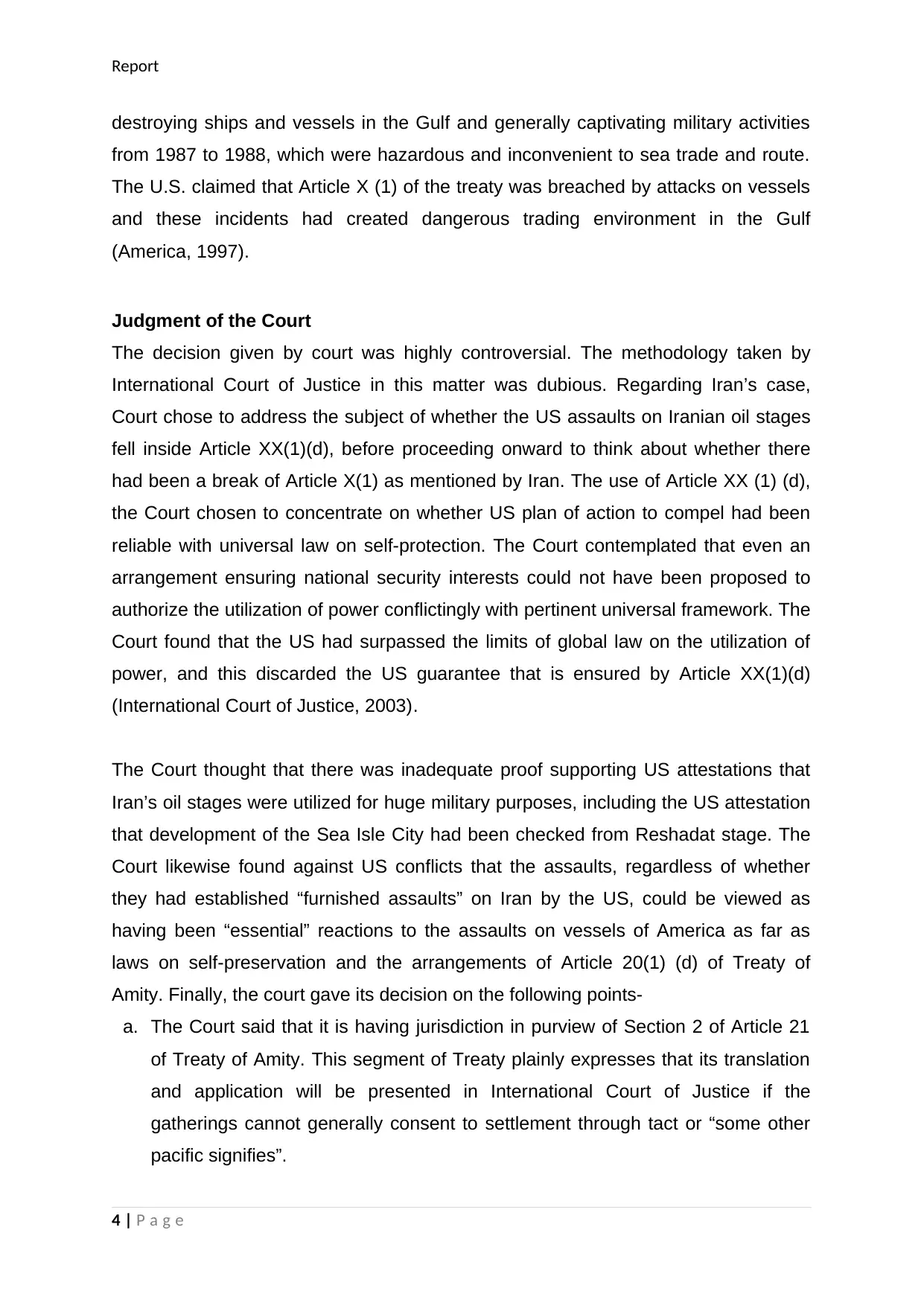
Report
destroying ships and vessels in the Gulf and generally captivating military activities
from 1987 to 1988, which were hazardous and inconvenient to sea trade and route.
The U.S. claimed that Article X (1) of the treaty was breached by attacks on vessels
and these incidents had created dangerous trading environment in the Gulf
(America, 1997).
Judgment of the Court
The decision given by court was highly controversial. The methodology taken by
International Court of Justice in this matter was dubious. Regarding Iran’s case,
Court chose to address the subject of whether the US assaults on Iranian oil stages
fell inside Article XX(1)(d), before proceeding onward to think about whether there
had been a break of Article X(1) as mentioned by Iran. The use of Article XX (1) (d),
the Court chosen to concentrate on whether US plan of action to compel had been
reliable with universal law on self-protection. The Court contemplated that even an
arrangement ensuring national security interests could not have been proposed to
authorize the utilization of power conflictingly with pertinent universal framework. The
Court found that the US had surpassed the limits of global law on the utilization of
power, and this discarded the US guarantee that is ensured by Article XX(1)(d)
(International Court of Justice, 2003).
The Court thought that there was inadequate proof supporting US attestations that
Iran’s oil stages were utilized for huge military purposes, including the US attestation
that development of the Sea Isle City had been checked from Reshadat stage. The
Court likewise found against US conflicts that the assaults, regardless of whether
they had established “furnished assaults” on Iran by the US, could be viewed as
having been “essential” reactions to the assaults on vessels of America as far as
laws on self-preservation and the arrangements of Article 20(1) (d) of Treaty of
Amity. Finally, the court gave its decision on the following points-
a. The Court said that it is having jurisdiction in purview of Section 2 of Article 21
of Treaty of Amity. This segment of Treaty plainly expresses that its translation
and application will be presented in International Court of Justice if the
gatherings cannot generally consent to settlement through tact or “some other
pacific signifies”.
4 | P a g e
destroying ships and vessels in the Gulf and generally captivating military activities
from 1987 to 1988, which were hazardous and inconvenient to sea trade and route.
The U.S. claimed that Article X (1) of the treaty was breached by attacks on vessels
and these incidents had created dangerous trading environment in the Gulf
(America, 1997).
Judgment of the Court
The decision given by court was highly controversial. The methodology taken by
International Court of Justice in this matter was dubious. Regarding Iran’s case,
Court chose to address the subject of whether the US assaults on Iranian oil stages
fell inside Article XX(1)(d), before proceeding onward to think about whether there
had been a break of Article X(1) as mentioned by Iran. The use of Article XX (1) (d),
the Court chosen to concentrate on whether US plan of action to compel had been
reliable with universal law on self-protection. The Court contemplated that even an
arrangement ensuring national security interests could not have been proposed to
authorize the utilization of power conflictingly with pertinent universal framework. The
Court found that the US had surpassed the limits of global law on the utilization of
power, and this discarded the US guarantee that is ensured by Article XX(1)(d)
(International Court of Justice, 2003).
The Court thought that there was inadequate proof supporting US attestations that
Iran’s oil stages were utilized for huge military purposes, including the US attestation
that development of the Sea Isle City had been checked from Reshadat stage. The
Court likewise found against US conflicts that the assaults, regardless of whether
they had established “furnished assaults” on Iran by the US, could be viewed as
having been “essential” reactions to the assaults on vessels of America as far as
laws on self-preservation and the arrangements of Article 20(1) (d) of Treaty of
Amity. Finally, the court gave its decision on the following points-
a. The Court said that it is having jurisdiction in purview of Section 2 of Article 21
of Treaty of Amity. This segment of Treaty plainly expresses that its translation
and application will be presented in International Court of Justice if the
gatherings cannot generally consent to settlement through tact or “some other
pacific signifies”.
4 | P a g e
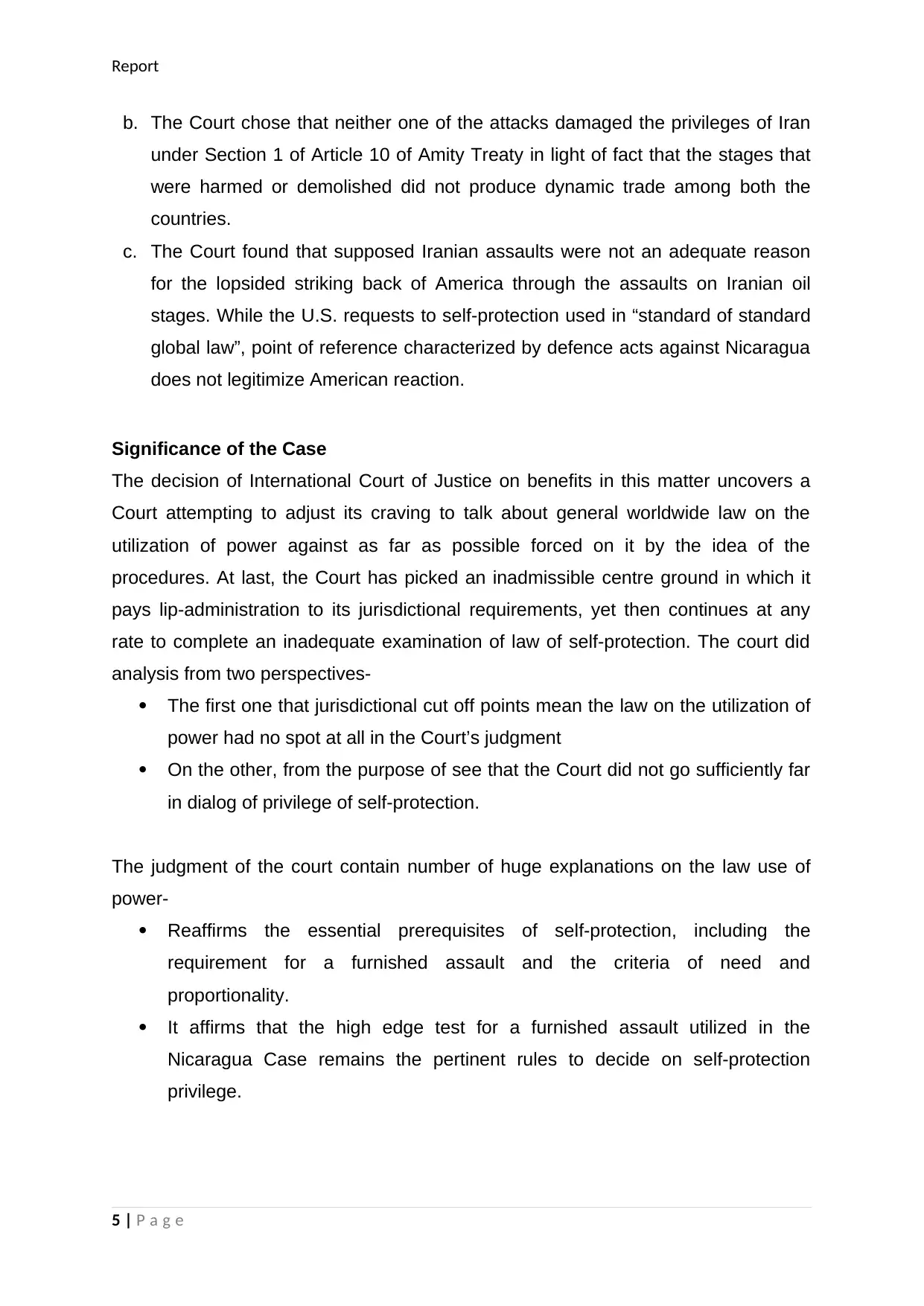
Report
b. The Court chose that neither one of the attacks damaged the privileges of Iran
under Section 1 of Article 10 of Amity Treaty in light of fact that the stages that
were harmed or demolished did not produce dynamic trade among both the
countries.
c. The Court found that supposed Iranian assaults were not an adequate reason
for the lopsided striking back of America through the assaults on Iranian oil
stages. While the U.S. requests to self-protection used in “standard of standard
global law”, point of reference characterized by defence acts against Nicaragua
does not legitimize American reaction.
Significance of the Case
The decision of International Court of Justice on benefits in this matter uncovers a
Court attempting to adjust its craving to talk about general worldwide law on the
utilization of power against as far as possible forced on it by the idea of the
procedures. At last, the Court has picked an inadmissible centre ground in which it
pays lip-administration to its jurisdictional requirements, yet then continues at any
rate to complete an inadequate examination of law of self-protection. The court did
analysis from two perspectives-
The first one that jurisdictional cut off points mean the law on the utilization of
power had no spot at all in the Court’s judgment
On the other, from the purpose of see that the Court did not go sufficiently far
in dialog of privilege of self-protection.
The judgment of the court contain number of huge explanations on the law use of
power-
Reaffirms the essential prerequisites of self-protection, including the
requirement for a furnished assault and the criteria of need and
proportionality.
It affirms that the high edge test for a furnished assault utilized in the
Nicaragua Case remains the pertinent rules to decide on self-protection
privilege.
5 | P a g e
b. The Court chose that neither one of the attacks damaged the privileges of Iran
under Section 1 of Article 10 of Amity Treaty in light of fact that the stages that
were harmed or demolished did not produce dynamic trade among both the
countries.
c. The Court found that supposed Iranian assaults were not an adequate reason
for the lopsided striking back of America through the assaults on Iranian oil
stages. While the U.S. requests to self-protection used in “standard of standard
global law”, point of reference characterized by defence acts against Nicaragua
does not legitimize American reaction.
Significance of the Case
The decision of International Court of Justice on benefits in this matter uncovers a
Court attempting to adjust its craving to talk about general worldwide law on the
utilization of power against as far as possible forced on it by the idea of the
procedures. At last, the Court has picked an inadmissible centre ground in which it
pays lip-administration to its jurisdictional requirements, yet then continues at any
rate to complete an inadequate examination of law of self-protection. The court did
analysis from two perspectives-
The first one that jurisdictional cut off points mean the law on the utilization of
power had no spot at all in the Court’s judgment
On the other, from the purpose of see that the Court did not go sufficiently far
in dialog of privilege of self-protection.
The judgment of the court contain number of huge explanations on the law use of
power-
Reaffirms the essential prerequisites of self-protection, including the
requirement for a furnished assault and the criteria of need and
proportionality.
It affirms that the high edge test for a furnished assault utilized in the
Nicaragua Case remains the pertinent rules to decide on self-protection
privilege.
5 | P a g e
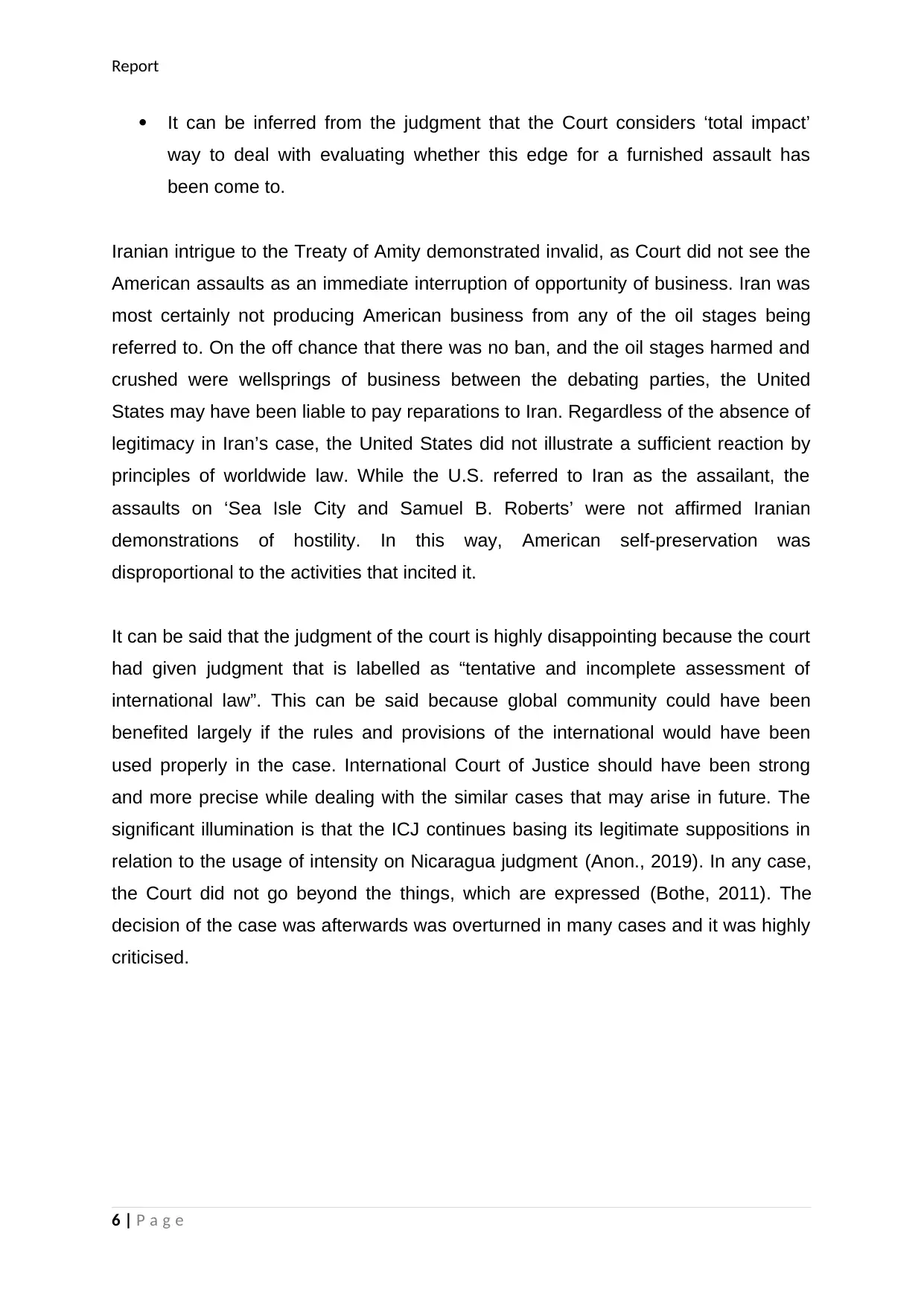
Report
It can be inferred from the judgment that the Court considers ‘total impact’
way to deal with evaluating whether this edge for a furnished assault has
been come to.
Iranian intrigue to the Treaty of Amity demonstrated invalid, as Court did not see the
American assaults as an immediate interruption of opportunity of business. Iran was
most certainly not producing American business from any of the oil stages being
referred to. On the off chance that there was no ban, and the oil stages harmed and
crushed were wellsprings of business between the debating parties, the United
States may have been liable to pay reparations to Iran. Regardless of the absence of
legitimacy in Iran’s case, the United States did not illustrate a sufficient reaction by
principles of worldwide law. While the U.S. referred to Iran as the assailant, the
assaults on ‘Sea Isle City and Samuel B. Roberts’ were not affirmed Iranian
demonstrations of hostility. In this way, American self-preservation was
disproportional to the activities that incited it.
It can be said that the judgment of the court is highly disappointing because the court
had given judgment that is labelled as “tentative and incomplete assessment of
international law”. This can be said because global community could have been
benefited largely if the rules and provisions of the international would have been
used properly in the case. International Court of Justice should have been strong
and more precise while dealing with the similar cases that may arise in future. The
significant illumination is that the ICJ continues basing its legitimate suppositions in
relation to the usage of intensity on Nicaragua judgment (Anon., 2019). In any case,
the Court did not go beyond the things, which are expressed (Bothe, 2011). The
decision of the case was afterwards was overturned in many cases and it was highly
criticised.
6 | P a g e
It can be inferred from the judgment that the Court considers ‘total impact’
way to deal with evaluating whether this edge for a furnished assault has
been come to.
Iranian intrigue to the Treaty of Amity demonstrated invalid, as Court did not see the
American assaults as an immediate interruption of opportunity of business. Iran was
most certainly not producing American business from any of the oil stages being
referred to. On the off chance that there was no ban, and the oil stages harmed and
crushed were wellsprings of business between the debating parties, the United
States may have been liable to pay reparations to Iran. Regardless of the absence of
legitimacy in Iran’s case, the United States did not illustrate a sufficient reaction by
principles of worldwide law. While the U.S. referred to Iran as the assailant, the
assaults on ‘Sea Isle City and Samuel B. Roberts’ were not affirmed Iranian
demonstrations of hostility. In this way, American self-preservation was
disproportional to the activities that incited it.
It can be said that the judgment of the court is highly disappointing because the court
had given judgment that is labelled as “tentative and incomplete assessment of
international law”. This can be said because global community could have been
benefited largely if the rules and provisions of the international would have been
used properly in the case. International Court of Justice should have been strong
and more precise while dealing with the similar cases that may arise in future. The
significant illumination is that the ICJ continues basing its legitimate suppositions in
relation to the usage of intensity on Nicaragua judgment (Anon., 2019). In any case,
the Court did not go beyond the things, which are expressed (Bothe, 2011). The
decision of the case was afterwards was overturned in many cases and it was highly
criticised.
6 | P a g e
Paraphrase This Document
Need a fresh take? Get an instant paraphrase of this document with our AI Paraphraser
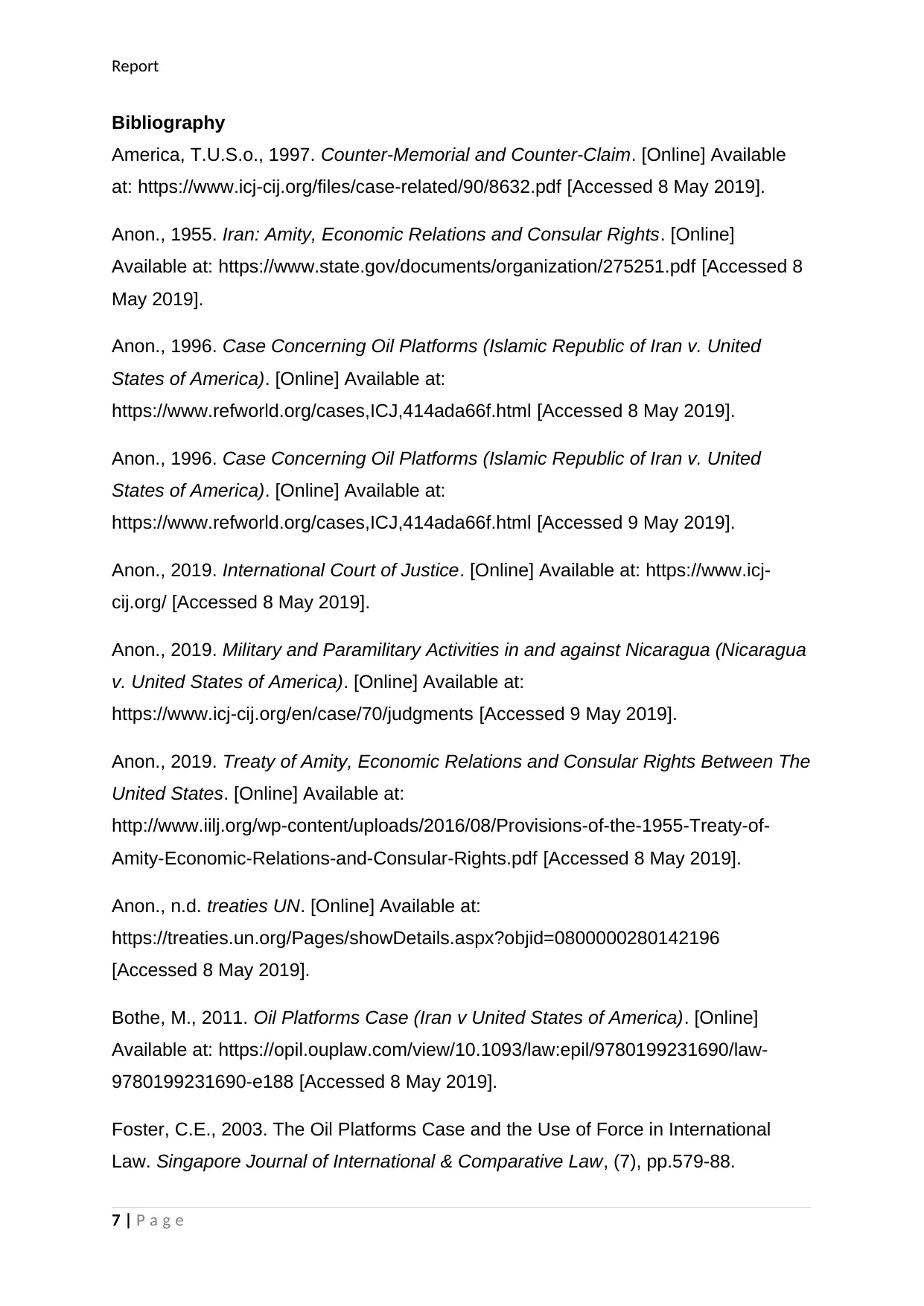
Report
Bibliography
America, T.U.S.o., 1997. Counter-Memorial and Counter-Claim. [Online] Available
at: https://www.icj-cij.org/files/case-related/90/8632.pdf [Accessed 8 May 2019].
Anon., 1955. Iran: Amity, Economic Relations and Consular Rights. [Online]
Available at: https://www.state.gov/documents/organization/275251.pdf [Accessed 8
May 2019].
Anon., 1996. Case Concerning Oil Platforms (Islamic Republic of Iran v. United
States of America). [Online] Available at:
https://www.refworld.org/cases,ICJ,414ada66f.html [Accessed 8 May 2019].
Anon., 1996. Case Concerning Oil Platforms (Islamic Republic of Iran v. United
States of America). [Online] Available at:
https://www.refworld.org/cases,ICJ,414ada66f.html [Accessed 9 May 2019].
Anon., 2019. International Court of Justice. [Online] Available at: https://www.icj-
cij.org/ [Accessed 8 May 2019].
Anon., 2019. Military and Paramilitary Activities in and against Nicaragua (Nicaragua
v. United States of America). [Online] Available at:
https://www.icj-cij.org/en/case/70/judgments [Accessed 9 May 2019].
Anon., 2019. Treaty of Amity, Economic Relations and Consular Rights Between The
United States. [Online] Available at:
http://www.iilj.org/wp-content/uploads/2016/08/Provisions-of-the-1955-Treaty-of-
Amity-Economic-Relations-and-Consular-Rights.pdf [Accessed 8 May 2019].
Anon., n.d. treaties UN. [Online] Available at:
https://treaties.un.org/Pages/showDetails.aspx?objid=0800000280142196
[Accessed 8 May 2019].
Bothe, M., 2011. Oil Platforms Case (Iran v United States of America). [Online]
Available at: https://opil.ouplaw.com/view/10.1093/law:epil/9780199231690/law-
9780199231690-e188 [Accessed 8 May 2019].
Foster, C.E., 2003. The Oil Platforms Case and the Use of Force in International
Law. Singapore Journal of International & Comparative Law, (7), pp.579-88.
7 | P a g e
Bibliography
America, T.U.S.o., 1997. Counter-Memorial and Counter-Claim. [Online] Available
at: https://www.icj-cij.org/files/case-related/90/8632.pdf [Accessed 8 May 2019].
Anon., 1955. Iran: Amity, Economic Relations and Consular Rights. [Online]
Available at: https://www.state.gov/documents/organization/275251.pdf [Accessed 8
May 2019].
Anon., 1996. Case Concerning Oil Platforms (Islamic Republic of Iran v. United
States of America). [Online] Available at:
https://www.refworld.org/cases,ICJ,414ada66f.html [Accessed 8 May 2019].
Anon., 1996. Case Concerning Oil Platforms (Islamic Republic of Iran v. United
States of America). [Online] Available at:
https://www.refworld.org/cases,ICJ,414ada66f.html [Accessed 9 May 2019].
Anon., 2019. International Court of Justice. [Online] Available at: https://www.icj-
cij.org/ [Accessed 8 May 2019].
Anon., 2019. Military and Paramilitary Activities in and against Nicaragua (Nicaragua
v. United States of America). [Online] Available at:
https://www.icj-cij.org/en/case/70/judgments [Accessed 9 May 2019].
Anon., 2019. Treaty of Amity, Economic Relations and Consular Rights Between The
United States. [Online] Available at:
http://www.iilj.org/wp-content/uploads/2016/08/Provisions-of-the-1955-Treaty-of-
Amity-Economic-Relations-and-Consular-Rights.pdf [Accessed 8 May 2019].
Anon., n.d. treaties UN. [Online] Available at:
https://treaties.un.org/Pages/showDetails.aspx?objid=0800000280142196
[Accessed 8 May 2019].
Bothe, M., 2011. Oil Platforms Case (Iran v United States of America). [Online]
Available at: https://opil.ouplaw.com/view/10.1093/law:epil/9780199231690/law-
9780199231690-e188 [Accessed 8 May 2019].
Foster, C.E., 2003. The Oil Platforms Case and the Use of Force in International
Law. Singapore Journal of International & Comparative Law, (7), pp.579-88.
7 | P a g e
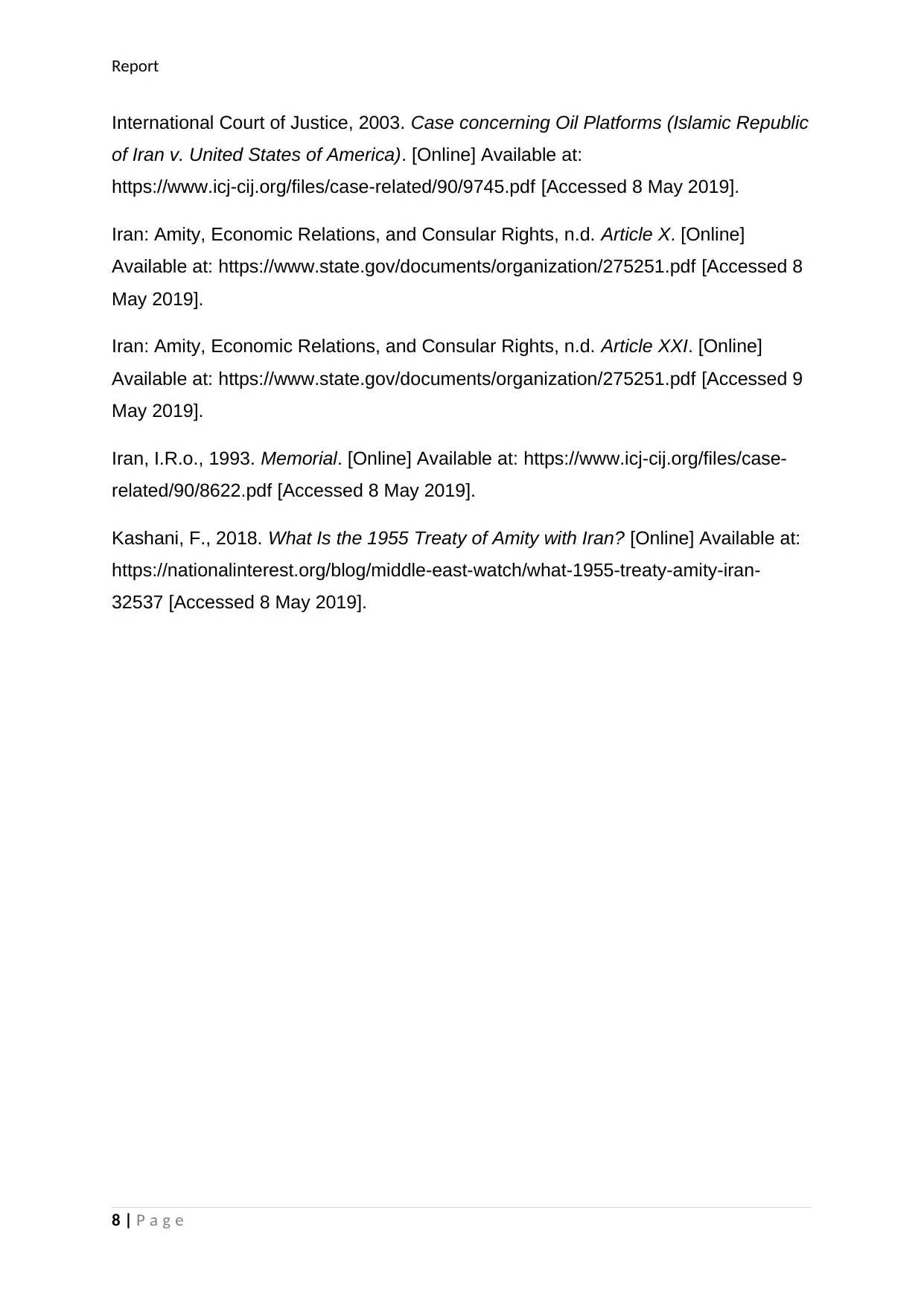
Report
International Court of Justice, 2003. Case concerning Oil Platforms (Islamic Republic
of Iran v. United States of America). [Online] Available at:
https://www.icj-cij.org/files/case-related/90/9745.pdf [Accessed 8 May 2019].
Iran: Amity, Economic Relations, and Consular Rights, n.d. Article X. [Online]
Available at: https://www.state.gov/documents/organization/275251.pdf [Accessed 8
May 2019].
Iran: Amity, Economic Relations, and Consular Rights, n.d. Article XXI. [Online]
Available at: https://www.state.gov/documents/organization/275251.pdf [Accessed 9
May 2019].
Iran, I.R.o., 1993. Memorial. [Online] Available at: https://www.icj-cij.org/files/case-
related/90/8622.pdf [Accessed 8 May 2019].
Kashani, F., 2018. What Is the 1955 Treaty of Amity with Iran? [Online] Available at:
https://nationalinterest.org/blog/middle-east-watch/what-1955-treaty-amity-iran-
32537 [Accessed 8 May 2019].
8 | P a g e
International Court of Justice, 2003. Case concerning Oil Platforms (Islamic Republic
of Iran v. United States of America). [Online] Available at:
https://www.icj-cij.org/files/case-related/90/9745.pdf [Accessed 8 May 2019].
Iran: Amity, Economic Relations, and Consular Rights, n.d. Article X. [Online]
Available at: https://www.state.gov/documents/organization/275251.pdf [Accessed 8
May 2019].
Iran: Amity, Economic Relations, and Consular Rights, n.d. Article XXI. [Online]
Available at: https://www.state.gov/documents/organization/275251.pdf [Accessed 9
May 2019].
Iran, I.R.o., 1993. Memorial. [Online] Available at: https://www.icj-cij.org/files/case-
related/90/8622.pdf [Accessed 8 May 2019].
Kashani, F., 2018. What Is the 1955 Treaty of Amity with Iran? [Online] Available at:
https://nationalinterest.org/blog/middle-east-watch/what-1955-treaty-amity-iran-
32537 [Accessed 8 May 2019].
8 | P a g e
1 out of 9
Your All-in-One AI-Powered Toolkit for Academic Success.
+13062052269
info@desklib.com
Available 24*7 on WhatsApp / Email
![[object Object]](/_next/static/media/star-bottom.7253800d.svg)
Unlock your academic potential
© 2024 | Zucol Services PVT LTD | All rights reserved.

